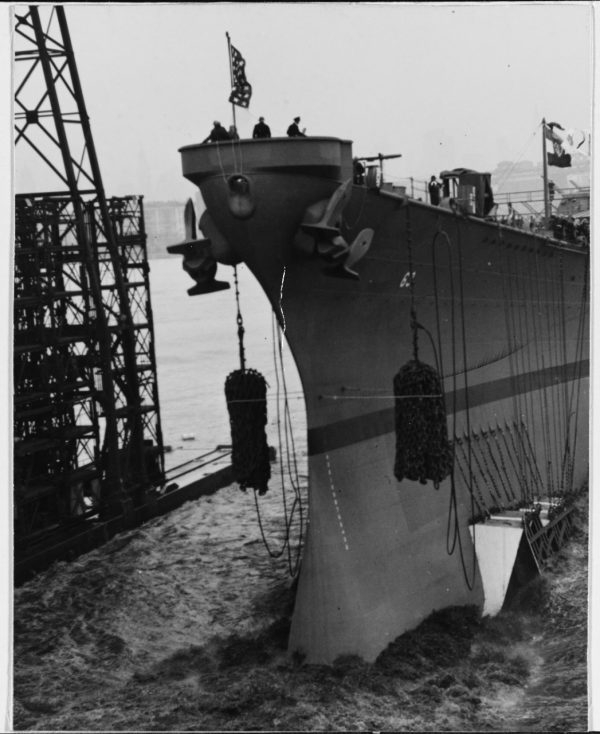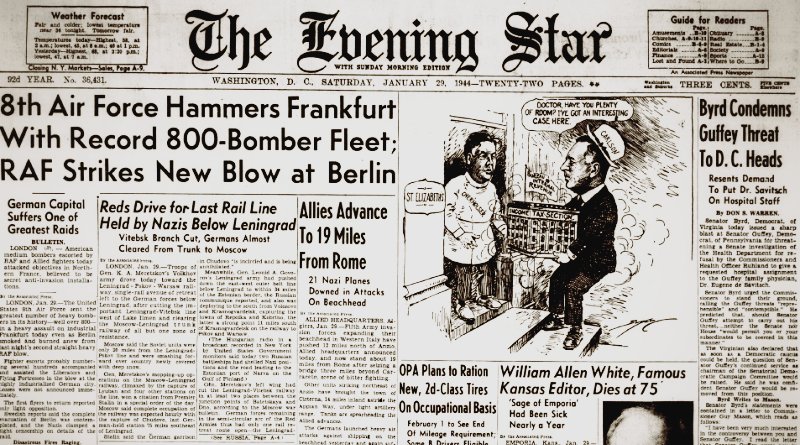World War II Chronicle: January 29, 1944
Click here for TODAY’S NEWSPAPER
Several accounts of Japanese acts of torture on American prisoners of war on page two. Former University of Maryland track star Mason F. Chronister is reported to have been killed (see page two) while in Japanese captivity in the Philippines. 1st Lt. Chronister served with Company B, 1st Battalion, 4th Marine Regiment and was captured at Corregidor Island. He was sent to Cabanatuan Prison Camp and was in fact killed when Philippine guerillas ambushed his work detail on June 17, 1942 on a work detail. George Fielding Eliot’s column discusses Japanese brutality on page six…
Retired Maj. Gen. George H. Cameron, who commanded 4th Infantry Division and V Corps during World War I, has passed away. Cameron graduated West Point in 1883 and was commissioned a cavalry officer. He served in the Indian and Philippine-American Wars before shipping to Europe with the American Expeditionary Force…
Sports on page 12, featuring a column by Grantland Rice… Several thousand people watched as the battleship USS Missouri launched at Brooklyn Navy Yards, nine months ahead of schedule. The “Mighty Mo” has a few months of fitting out and sea trials before she can enter the war…

Roving Reporter by Ernie Pyle
IN ITALY — The several Air Force units I’ve been with lately are lousy with Hoosiers. I thought I’d take down their names and put them in the column, but the list got so long I realized it would sound like discrimination and the 47 other States might get mad at me.
So I decided to compromise and name only one. He is Lieut. James F. Short of Clinton, Ind. He has been in the Army four years, and was a sergeant up until he got his commission a year ago. He calls himself “one of the 90-day wonders.” He’s only 22, and he is assistant operations officer of this squadron.
The reason I picked Lieut. Short out of all the Hoosiers is that he was born and raised five miles from that proud metropolis from which I sprang — Dana, Ind.
One afternoon on our field we had an exciting half hour. We had two full groups of dive-bombers on the field plus a menagerie of night fighters, day fighters, photo planes, light bombers and cargo ships. We were all standing out waiting for our squadron to come back from a mission, when lo and behold the entire caboodle came back at once. It was the damnest melee in the sky you ever saw. It was as though somebody had broken open a hornet’s nest.
One group of dive-bombers approached the field from one direction, and the other from the opposite, at exactly the same time. They both came over the field at about 400 feet, and when they met at midrunway they all chandelled off in a thousand directions.
Before that I had thought there were only 360 points on the compass, but now we all know better. Planes were going in at least three times that many directions.
In the midst of all this confusion a Flying Fortress flew over the field and we saw white parachutes begin to spring out behind it. At first we thought they must be having a practice jump, but you don’t make practice jumps over a front-line. The plane was in trouble.
One by one those scores of dive-bombers got themselves successfully landed, and in the meantime seven parachutes had come out of the Fortress. That meant three still inside, and she was still flying.
Finally the air was clear and the Fortress approached for a landing. The entire complement of the field, several thousand men were standing on top of anything they could find to see the excitement, and the ambulance and fire trucks were all ready. As the Fort approached the field we could see that the bomb-bay doors were still open.
The big plane touched the runway as softly as down, rolled straight in and gradually came to a stop, and we all heaved sighs of relief. The fliers on the ground began acting comically exaggerated scenes of how the ambulance drivers’ faces would fall as they’d reach over in disgust and turn off their switches.
A little later we went around and got the story on the Fortress. One of those unbelievable things had happened that sometimes occur in the best regulated wars. A fellow Flying Fortress had dropped its bombs on this one in midair.
Fortunately they were only carrying 25-pound fragmentation bombs that day instead of large ones. A couple of these bombs had blown the left wing full of great jagged holes, had knocked out one engine and the radio, and jammed the bomb-bay doors.
But that’s the mildest part of the story. The pay-off was that one bomb hadn’t gone off and was still lodged inside the Fortress’ wing, liable to explode at any moment and blow the wing clear off.
When we finally left the plane was roped off, the field engineering officer had got a tall stepladder, had climbed up to the wing, and had been standing there on the stepladder for an hour looking down at the bomb and wondering why the hell he ever chose to be an engineer anyway.
Later that evening some of our pilots and I went to a neighboring field to see some friends. They were complaining about the traffic on their field and said they believed they’d bring their 50 planes over to our field. At which we all howled and said: “Sure, come on over. In the confusion over there you would not even be noticed.”
Evening star. (Washington, D.C.), 29 January 1944. Chronicling America: Historic American Newspapers. Lib. of Congress.
https://chroniclingamerica.loc.gov/lccn/sn83045462/1944-01-29/ed-1/
